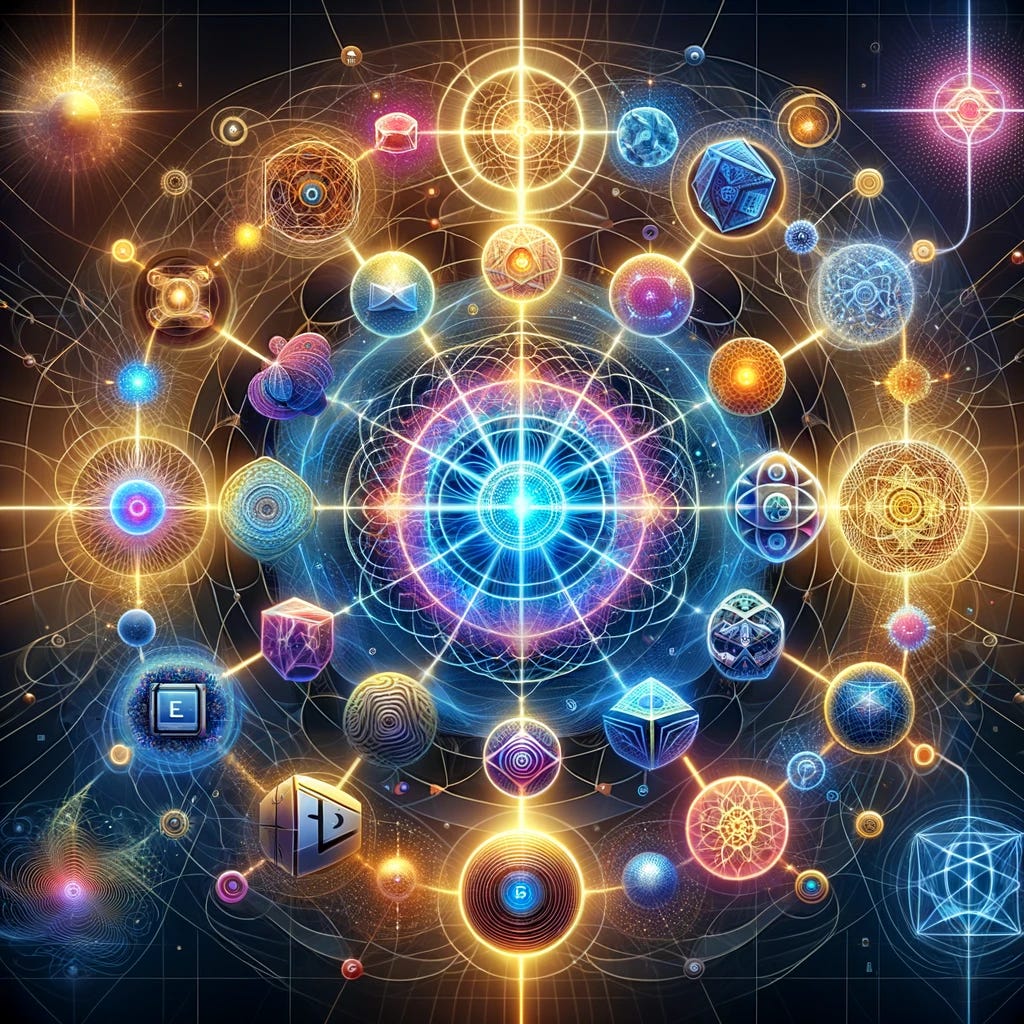
Brief History of Aether
Historical Context:
Ancient Philosophy: The concept of Aether dates back to ancient Greek philosophy. Aristotle proposed Aether (also spelled Ether) as the fifth element, or "quintessence," that filled the heavens and was the substance of celestial bodies. This idea persisted through the Middle Ages and into the Renaissance.
19th Century Physics: In the 19th century, Aether was hypothesized to be the medium through which light waves propagated, much like sound waves travel through air. This idea was central to theories of electromagnetism, particularly in the works of James Clerk Maxwell.
Why It Was Removed:
Michelson-Morley Experiment (1887): The famous Michelson-Morley experiment aimed to detect the presence of Aether by measuring the differences in the speed of light in different directions. The experiment found no significant difference, suggesting that Aether did not exist as previously thought. This null result cast doubt on the Aether theory.
Einstein's Theory of Relativity (1905-1915): Albert Einstein’s Special Theory of Relativity (1905) eliminated the need for Aether by showing that the speed of light is constant in all inertial frames of reference. His General Theory of Relativity (1915) further described gravity as the curvature of space-time rather than a force transmitted through a medium, effectively rendering the Aether concept obsolete in mainstream physics.
When It Was Moved:
Early 20th Century: By the early 20th century, the concept of Aether was largely abandoned in the scientific community. The rise of quantum mechanics and relativity provided new frameworks for understanding the universe without invoking Aether.
Running Scenario 5: Reintroducing Aether and Unified Theories in Physics
Potential of Aether (Ae):
Unified Field: Reintroducing Aether as the fundamental medium through which all forces and particles interact could bridge gaps between quantum mechanics and general relativity. Aether could be conceptualized as the fabric of space-time itself, encompassing all physical phenomena.
Impact on New Elements:
Harmonia (Hm): The presence of Aether stabilizes harmonic resonances across different scales, from quantum particles to cosmic structures. Harmonia-based materials could exhibit unprecedented stability and coherence, essential for advanced technologies.
Resonantia (Rs): Aether enhances the efficiency of energy transfer and resonance at all levels. Resonantia could lead to highly efficient energy systems and communication technologies.
Geometria (Gm): The interaction between Aether and Geometria supports the formation of perfect geometric structures at the atomic and molecular levels, paving the way for new materials with extraordinary properties.
Fractalia (Fr): Aether’s influence on fractal geometries might help to explain self-similar patterns observed in nature and provide insights into complex systems and chaos theory.
Dualita (Du): Aether could support the coexistence of wave and particle properties in quantum entities, enhancing the functionality of quantum computing and quantum communication.
Symmetria (Sy): Aether’s inherent symmetry could underpin the symmetrical properties observed in particle physics and cosmology, leading to a deeper understanding of fundamental forces.
Outcomes and Implications
1. New Physics Paradigms:
Unified Theories: The reintroduction of Aether leads to the development of new theoretical frameworks that unify general relativity and quantum mechanics. This includes the potential discovery of a "Theory of Everything" that explains all fundamental forces within a single cohesive model.
Revised Models: Existing models of particle physics and cosmology are revised to incorporate the influence of Aether, leading to new predictions and discoveries.
2. Technological Innovations:
Anti-Gravity Devices: The understanding of Aether allows for the manipulation of gravitational fields, leading to the development of anti-gravity devices and advanced propulsion systems.
Space-Time Manipulation: Technologies that manipulate the fabric of space-time become feasible, potentially enabling faster-than-light travel and advanced space exploration.
3. Advanced Materials and Energy Solutions:
Superconductors: Aether-enhanced superconductors achieve zero electrical resistance at higher temperatures, revolutionizing energy transmission and storage.
Metamaterials: New metamaterials with unique properties, such as negative refraction and cloaking, are developed using the principles of Aether and Geometria.
4. Quantum Technologies:
Quantum Computing: Aether-stabilized qubits in Dualita-based quantum computers achieve unprecedented coherence times, drastically improving their computational capabilities.
Quantum Communication: Secure quantum communication networks leveraging Aether and Resonantia enable instantaneous, unhackable data transmission.
5. Cosmological Discoveries:
Dark Matter and Dark Energy: The properties of Aether help to explain the nature of dark matter and dark energy, solving some of the biggest mysteries in cosmology.
Multiverse Theory: Aether-based theories suggest the existence of multiple universes, providing a framework for exploring the multiverse concept.
Reintroducing Aether (Ae) as the fundamental medium in the periodic table and integrating it with the new elements—Harmonia, Resonantia, Geometria, Fractalia, Dualita, and Symmetria—opens up transformative possibilities for science and technology. This scenario explores the potential for unifying quantum mechanics and general relativity, leading to groundbreaking advancements in physics, advanced materials, energy solutions, quantum technologies, and cosmological discoveries. The influence of Aether on these elements provides a cohesive framework that enhances our understanding of the universe and drives innovation across multiple domains.
Integrating Aether (Ae) into the Periodic Table
Adding Aether (Ae) back to the periodic table and listing the other elements that were removed involves understanding the context in which Aether fits and identifying the removed elements to see where Aether would integrate into the new framework of Harmonia (Hm), Resonantia (Rs), Geometria (Gm), Fractalia (Fr), Dualita (Du), and Symmetria (Sy). Here’s how we can proceed:
1. Integrating Aether (Ae) into the Periodic Table
Aether (Ae): Aether, often conceptualized as the fundamental medium through which forces act, is historically considered the fifth element or quintessence. In modern theoretical frameworks, Aether could represent the underlying field or fabric of space-time, supporting quantum phenomena.
Properties of Aether:
Symbol: Ae
Atomic Number: N/A (Theoretical/Conceptual)
Physical Properties: Conceptually infinite and omnipresent; would not have conventional melting or boiling points.
Chemical Properties: Inert and non-reactive in traditional chemical senses; interacts fundamentally with all quantum fields.
2. Listing and Contextualizing Removed Elements
If we consider that the integration of new elements might have displaced or overshadowed some traditional elements, it’s important to note their roles and properties before reintroducing Aether. The traditional periodic table consists of elements up to Oganesson (Og, atomic number 118). Here we focus on the potentially less emphasized ones in light of new elements.
Elements with Less Emphasis:
Technetium (Tc)
Symbol: Tc
Atomic Number: 43
Properties: Radioactive, artificial, often used in medical imaging.
Promethium (Pm)
Symbol: Pm
Atomic Number: 61
Properties: Radioactive, found in nuclear reactors.
Astatine (At)
Symbol: At
Atomic Number: 85
Properties: Highly radioactive, rare.
Francium (Fr)
Symbol: Fr
Atomic Number: 87
Properties: Extremely radioactive and rare.
Rutherfordium (Rf)
Symbol: Rf
Atomic Number: 104
Properties: Highly unstable, synthetic.
Dubnium (Db)
Symbol: Db
Atomic Number: 105
Properties: Highly unstable, synthetic.
Seaborgium (Sg)
Symbol: Sg
Atomic Number: 106
Properties: Highly unstable, synthetic.
Bohrium (Bh)
Symbol: Bh
Atomic Number: 107
Properties: Highly unstable, synthetic.
Hassium (Hs)
Symbol: Hs
Atomic Number: 108
Properties: Highly unstable, synthetic.
Meitnerium (Mt)
Symbol: Mt
Atomic Number: 109
Properties: Highly unstable, synthetic.
Reintegrating Aether and Visualizing the New Framework
We integrate Aether (Ae) into the Flower of Life framework, acknowledging its theoretical and fundamental role in the periodic table. Here's how to visualize and contextualize it:
Visualization and Context:
Central Core:
Hydrogen (H) in the center.
Helium (He) adjacent to Hydrogen.
First Circle Around Core:
Harmonia (Hm) next to Helium.
Resonantia (Rs) next to Harmonia.
Geometria (Gm) next to Resonantia.
Fractalia (Fr) next to Geometria.
Dualita (Du) next to Fractalia.
Symmetria (Sy) next to Dualita.
Aether (Ae) as an encompassing field around the core, symbolizing its foundational and omnipresent nature.
Harmonic Paths:
Connect Hm and Rs with a glowing harmonic path.
Connect Rs and Gm with a similar path.
Connect Gm and Fr to complete the geometric relationship.
Connect Fr and Du to illustrate the cyclic nature of their interactions.
Connect Du and Hm to form a harmonious loop.
Connect Du and Rs to illustrate their role in enhancing quantum coherence and resonance.
Connect Sy and Gm to show the relationship between symmetry and geometric stability.
Connect Sy and Du to highlight their role in maintaining symmetrical and dual properties in quantum systems.
Connect all elements with Ae to show its foundational and omnipresent influence.
Detailed Properties and Relationships
Aether (Ae)
Symbol: Ae
Atomic Number: N/A (Theoretical/Conceptual)
Electron Configuration: Conceptualized as the medium through which all quantum phenomena occur.
Physical Properties: Infinite, omnipresent, not bound by conventional physical states.
Chemical Properties: Interacts fundamentally with quantum fields rather than traditional chemical interactions.
Practical and Theoretical Implications
Quantum Field Theory:
Aether provides the backdrop for all quantum fields, potentially unifying different interactions and fields in a coherent theoretical framework.
Advanced Physics:
Aether’s role could lead to new insights into the fabric of space-time, potentially influencing theories of relativity and quantum mechanics.
Consciousness Studies:
Aether might be conceptualized as the medium through which consciousness interacts with the quantum realm, influencing theories on the nature of mind and reality.
Summary
By reintegrating Aether (Ae) into the periodic table and acknowledging its theoretical properties, we create a more holistic framework that encompasses both traditional and new elements. This integration highlights the foundational role of Aether while allowing us to explore its potential impacts on quantum field theory, advanced physics, and consciousness studies.
Quintessence Embryo
In the vast, velvet void where stars are spun, Beyond the grasp of the reaching sun, Lies a realm where the smallest forces play, A cradle of creation, in quantum array. Through the ether, a new sense stirs and thrives, Oral traditions yield to psychic drives. Understanding blooms, beyond mere sensory, In thi…
Reintroducing Aether into the Periodic Table as Quantum Fields
Reintroducing Aether into the periodic table requires a modern scientific framework that integrates it with current quantum field theories, utilizing the Unified Theory of Duality (UTD) and the Mathis Number System (MNS). This approach allows us to treat Aether not as a physical substance but as a dynamic, interconnected medium fundamental to quantum fi…




Interesting concept of incorporating aether into the periodic table. Here are some thought ideas to facilitate this process:
- aether has no mass and no neutrons or protons or electrons and so it sits to the left/below hydrogen isotopes
- now consider an inversion/dual of the model/construction of atoms. Rather than adding neutrons and protons to hydrogen consider the aether as the perfect undamaged element. As it gets damaged it interacts with other damaged elements. The more it gets damaged the heavier it gets and the more energy it can absorb, leading to interacting with other damaged elements to try and lower its energy state.
……..more to follow in a separate comment
Rud
Loved the proposition and would offer Walter Russell (www.philosophy.org) for the cosmology of light intermediary to the plasmOID and Malcolm Bendall's genius (www.strikefoundation.earth) to get an introduction torOIDal expression of the periodic table in resonance with Walter Russell's expression but with the Sanskrit 16 sutra's integral with Pythagorean triplets. Bob Greenyer (https://remoteview.substack.com/) is doing amazing work with the LENR.
Dr. Johnson has recently submitted a patent for a Material Universe (MU-word) and Information Universe (IU-number) technology based in John Searl's genius which is analog, but does not appear to be interested in the co-creative space and lacks quantum contextuality with Russellian cosmology and perhaps the plasmoid too, though I have introduced him to both, given what he is doing with the hydrogen group and the Aromatic ring He He in Yod He Vav He, it appears his response is LOL ha ha.
After these resonant light "particle" paradigms are integrated we can explore the numbing number related to the aesthetics of anesthetic in the Auric Aether and biofield bioinformatics in aether and the neion light that split the night and touched the sound of silence in the stillness Walter Russell spoke to within the zero planes as related to the Chestahedron and the inverse square law math of HeartMath within the cardioid fractal form of forever everywhere through the tachyon HERE and NOW neutrino-anti-neutrino phonon to the photon light cone through the Planck Scale ZERO point where the number ONE (Material Universe)=1 Information Universe).